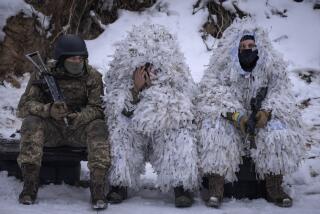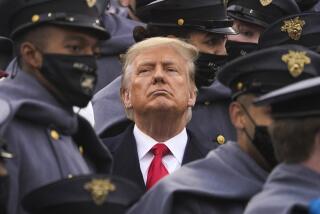Soviet Army’s Allegiance Is a Major Question Mark : Military: Western experts say the loyalty of demoralized troops is far from assured.
- Share via
WASHINGTON — Leaders of the Soviet coup have taken an enormous gamble in relying on the country’s 4.2-million-strong military, a demoralized force riven by ethnic and generational fissures, to enforce their seizure of power, Western analysts say.
Some units reportedly have already defected to the side of Russian Federation President Boris N. Yeltsin, who opposes the coup. The experts say that thousands of Soviet troops may disobey orders to fire on their compatriots if a violent crackdown is ordered.
The original takeover was carried out chiefly by special security units of the Interior Ministry and the KGB security police. But if civil disorder spreads, the coup leaders will be forced to rely on the regular army, whose loyalty to them is by no means assured, the analysts say.
The army, plagued by indiscipline, draft evasion and ethnic strife, is in a state of disarray, having endured an ignominious withdrawal from Afghanistan, squalid living conditions and several years of uncertainty about the political direction of the country.
Younger officers openly question the orders of their superiors and appear to have little stomach for the widespread repression that may be required to consolidate the coup, the U.S. analysts say.
“The key question for the junta is what units they can rely upon,” said Gabriel Schoenfeld, senior fellow in Soviet studies at the Center for Strategic and International Studies in Washington. “The general army is a rather frail institution to count upon to shoot the population.”
While the officer corps is almost exclusively Slavic, conscripts are largely drawn from more than 100 non-Russian Asian and Muslim nationalities, heightening frictions in a military that for decades has been marked by brutality and abuse of enlisted men.
Nearly a third of new recruits each year do not speak Russian, according to Soviet military officials. In a military composed largely of conscripts, the problem is growing worse because of much higher birthrates among non-Russian nationalities than in Russia itself.
“In the armed forces, there is no question who’s running it--it’s the Slavs. They are in command at top and they treat the minorities like scum,” said John M. Collins, senior foreign policy specialist at the Congressional Research Service.
“That’s another reason, under the circumstances that are developing, why the minorities who have been spat on for so long by their alleged leaders are not going to be so enthusiastic about following orders.”
Dissension in the ranks has been further fueled by poor living conditions for the tens of thousands of troops returning to the Soviet Union from former Eastern European satellites. Because of a severe housing shortage, many of the returned soldiers are encamped in huge tent cities outside Moscow, Leningrad and other large cities.
The pay for soldiers has long been a national joke and the military has not been immune from the pervasive food shortages plaguing the rest of the Soviet Union. Units are lucky to be fed meat once a week.
As a result, draft dodging, desertion and crime within the ranks are endemic, U.S. officials say. Lt. Gen. William Odom, retired director of the National Security Agency, said Tuesday that more than 20% of Soviet draftees failed to turn up for induction last year.
In addition, the army until now has studiously avoided involvement in domestic repression--in contrast to the Interior Ministry and the KGB, which bear specific responsibility for maintaining internal order.
Many had interpreted the presence of Defense Minister Dmitri T. Yazov among the coup leaders as a sign that the military, exhausted by the vacillations of the Gorbachev era, was stepping in to restore stability.
However, there were reports Tuesday that Yazov had been removed as one of the directors of the Emergency Committee because of unspecified health problems and had been replaced by Gen. Mikhail A. Moiseyev, chief of the Soviet general staff. But U.S. officials could not confirm the report, and Soviet officials denied that Yazov had left the ruling committee.
But even with a prominent military presence among the coup planners, there is a wide gulf between the senior military leadership and mid-level and younger officers, many of whom have been much more sympathetic to the reform movement.
“The ‘gang of eight’ has been inhibited from resorting to naked force in Russia in particular because they have been perfectly well aware there is dissension in the ranks, insubordination in the ranks, including in the senior ranks,” said Jeremy R. Azreal, an expert on the Soviet military at the RAND Corp. think tank in Santa Monica. “They know that if they gave an order to shoot in the face of massive civil disobedience, the troops might not fire, or if some fired, other units might fire on the firers.
“Their instruments of intimidation might be utterly inadequate as instruments of actual large-scale repression. They have known that for a long time and that has affected their behavior,” he said.
On the other hand, coup leaders might use ethnic differences to their advantage. There were unconfirmed reports from Moscow on Tuesday that elite Azerbaijani paratroopers had been seen assembling at airfields around the capital in preparation for an assault on pro-Yeltsin demonstrators. These same troops were used to crush dissent in the Baltic republics earlier this year.
“If the guys who have temporarily taken over bring in Central Asian troops who have no compunctions about shooting Slavs, it could get messy,” said George Carver, former deputy director of the CIA.
He suggested that the coup leaders may have returned to the Stalinist tactic of using troops from distant republics so that no one must carry out repressive actions against civilians in his home region. But Azreal said that ploy is not likely to succeed if unrest spreads broadly throughout the huge Russian Federation.
“Nobody knows who’s reliable. In every civil disorder in Russia--and the czarists did it before them--the central leadership tries not to use homeboys. But there aren’t enough non-Russian troops to suppress disorder in Russia.”
For now, the answer to the ethnic dilemma has been to employ the elite paramilitary units of the Interior Ministry and KGB, virtually all ethnic Russians and considered unquestionably loyal to their leaders, who are among the coup directors.
The Pentagon estimates that the Soviet Interior Ministry has 300,000 uniformed security troops, while the KGB troops number about 230,000. The Interior Ministry has created special “black beret” units trained for internal security missions and the KGB has never had compunctions about carrying out internal repression.
“They are willing to carry out acts of great brutality, but the problem is they have many problems to deal with and only a limited number of special teams, which up to now have been largely concentrated in the Baltics,” Schoenfeld said.
“The KGB has special border troops which could be used for nasty, intimidation-type missions, but not the resources for broad-scale operations,” he said. “If they have to deal with strikes spread over the whole Soviet Union, they just can’t put out that many brush fires at once.”
Who’s Wearing the Uniforms
The coup was carried out chiefly by special security units of the Ministry of Internal Affairs (MVD) and the KGB. But coup leaders now are relying on the military, which is demoralized and fractured. Here’s who’s who:
MVD: This agency administers the national police force and a force for maintaining internal security. The Pentagon estimates that the MVD has 300,000 uniformed troops for maintaining internal order. Y. V. Shatalin is in charge of the MVD internal troops.
KGB: Officially known as the Committee for State Security. Its basic function has been described as “not to allow the collapse of the Soviet Union from inside.” It collects intelligence, and its border troops are in charge of land and naval border security. It is headed by Chairman Vladimir A. Kryuchkov, who is a member of the eight-man committee that ousted President Mikhail S. Gorbachev and seized power. The Pentagon estimates that the KGB numbers about 230,000.
MILITARY: Under the control of Defense Minister Dmitri T. Yazov. Until now, the Soviet military has avoided involvement in domestic repression. There are five branches, each headed by a commander in chief of military rank who also is a deputy minister of defense. The five services are: Strategic Rocket Forces, Ground Forces, Troops of Air Defense, Air Forces and Navy. The Soviet president is overall commander in chief.
QUESTIONS OF LOYALTY: The 4.2-million-man military is plagued by indiscipline, draft evasion and other internal divisions:
Ethnic strife: There is friction between the mostly Slavic officer corps and lower-ranking troops, largely from Russian Asian and Muslim nationalities.
Political division: Some units already have defected to the side of Boris N. Yeltsin, leader of the Russian Federation. Experts say thousands of troops may disobey orders to fire on their compatriots if a violent crackdown is ordered.
Sources: U.S. Department of Defense, Naval Institute, Los Angeles Times
More to Read
Sign up for Essential California
The most important California stories and recommendations in your inbox every morning.
You may occasionally receive promotional content from the Los Angeles Times.










